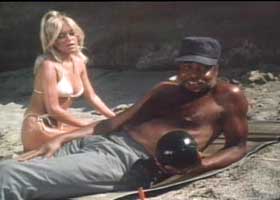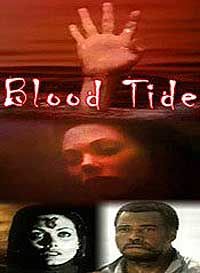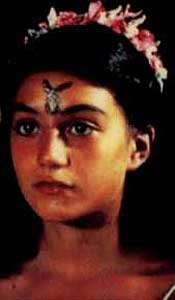Blood Tide (1982), set on an obscure Greek island, has also been known as Demon Island or The Red Tide. It's an awful film yet it has to be given a position of some consequences because of a fine central performance (vastly better than the film as a whole) by James Earl Jones.
 Its treatment of the relationship between its black nihilistic hero Frye (Jones) & his white gal pal Barbara (Lydia Cornell) was still rare in 1982. Its treatment of the relationship between its black nihilistic hero Frye (Jones) & his white gal pal Barbara (Lydia Cornell) was still rare in 1982.
Though a decade had passed since the first on-screen kiss between the races (in Omega Man), it had remained rare even that a white man kissed a black woman on screen, & rarer still for a black man to be shown coupled with a white woman.
Jones & Cornell were denied their on-screen kiss in Blood Tide, just as a decade later Denzel Washington would not be permitted an on-screen kiss with Julia Roberts in The Pelican Brief & they were reduced to exchanging knowing glances long-distance while Julia watched Denzel on television, one of the more moronic examples of subliminal racism in American cinema.
 Blood Tide makes it clear that the relationship between Frye & Barbara is sexual & mutually enriching, with no underlying message of fear or disrespect of black male sexuality. Such a cross racial couple was all but unheard of in cinema at the time. In exploitation cinema until then, any black character interested in white women was not apt to be the hero. Blood Tide makes it clear that the relationship between Frye & Barbara is sexual & mutually enriching, with no underlying message of fear or disrespect of black male sexuality. Such a cross racial couple was all but unheard of in cinema at the time. In exploitation cinema until then, any black character interested in white women was not apt to be the hero.
The film begins with an effectively moody scene of ancient Greek sacrifice of a virgin (Irini Tripkou) to some amphibious god-monster seen only as roiling water. It could be a only shark or it could be the dog-headed sea monster seen in mythic art.
The story immediately cuts to the modern Greek isle where expatriots observe the reticent islanders' traditional dances & mumming of ancient beliefs & rituals. The local mayor, Nereus (Jose Ferrer taking mediocre roles at the end of his career) seems possibly to be the head of a revived cult if not merely its advocate.
When we eventually glimpse the monster it's too dumb by a factor of ten, so it's fortunate that the human players' various states of mind & their actions is the main focus throughout. That the monster is scarsely in the story at all makes it a profound disappointment as an alleged monster flick, & the story's pacing is boring.
A bit of nunsploitation (Lila Kedrova as the main doomed nun) gives the film its primary oomph of sleeze, but it otherwise does very little that might entertain even down-market.
It remains that James Earl Jones gives the picture more credibility than it would otherwise achieve. Jones provides the climax, avenging Barbara against the monster. He blows up the cave & stays in it to die with the monster. Black men seem always to have to die in monster pictures but at least Jones goes out the central hero, not the minority sidekick who dies so that massah can live.
The script's storyline could easily have been handed over to the sister & brother team (Deborah Shelton & Martin Kove) but fortunately someone knew who was playing the only character anyone would ever care about. Jones is definitely the lead, despite that he did not have top billing in the original release, but only in retrospect when all the other actors are long forgotten.
It's too bad the final heroic confrontation with the monster lacked sufficient budget for the monster to be shown as more than stirred water, & it's too bad Jones wasn't lending his talent to something overall a bit more memorable. But for black heros in vintage cinema, one takes what one can find.
copyright © by Paghat the Ratgirl
|

 Its treatment of the relationship between its black nihilistic hero Frye (Jones) & his white gal pal Barbara (Lydia Cornell) was still rare in 1982.
Its treatment of the relationship between its black nihilistic hero Frye (Jones) & his white gal pal Barbara (Lydia Cornell) was still rare in 1982. Blood Tide makes it clear that the relationship between Frye & Barbara is sexual & mutually enriching, with no underlying message of fear or disrespect of black male sexuality. Such a cross racial couple was all but unheard of in cinema at the time. In exploitation cinema until then, any black character interested in white women was not apt to be the hero.
Blood Tide makes it clear that the relationship between Frye & Barbara is sexual & mutually enriching, with no underlying message of fear or disrespect of black male sexuality. Such a cross racial couple was all but unheard of in cinema at the time. In exploitation cinema until then, any black character interested in white women was not apt to be the hero.